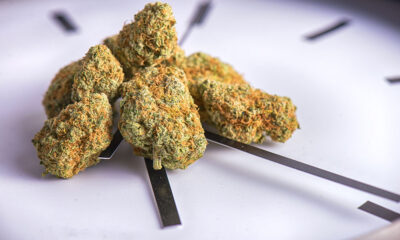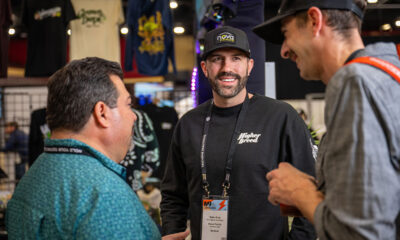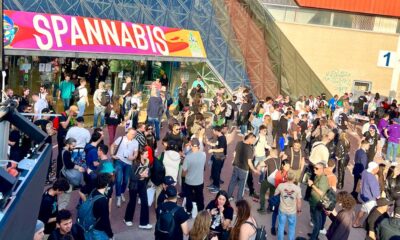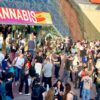
Industry Events
Is Cannabis Legalization Killing Weed Events?
Long lines, difficult sales and looming authorities at the first COVID-era Emerald Cup Harvest Ball reveal a hard truth: Laws need to change for cannabis events to be viable.
There was plenty of weed at the recent “Harvest Ball,” the first edition of the newly rechristened mid-December cannabis event which was focused on celebrating northern California’s sungrown harvest, formerly known as the Emerald Cup. (The official “Emerald Cup” happens in May in Los Angeles at Green Street Festival.) This non-Emerald Cup was just the “road to the Cup,” if you follow. The only trouble was getting your hands on any weed without burning an hour waiting in line or running afoul of the law.
The first big cannabis event to happen in California in the COVID-19 era that’s not a business conference, the Harvest Ball was also the first cannabis-consumer forward event to happen under the watchful eye of the new Department of Cannabis Control (DCC), the single state agency formed last summer by Gov. Gavin Newsom. It was also the first “Emerald Cup” event to happen after the brand’s new format signaled a shift away from its Emerald Triangle roots and towards population centers in Southern California.
For all these reasons—COVID, Newsom, rules, commercialization—significant changes were inevitable. Much has happened since the old days of bursting turkey bags and mason jars stuffed with head stashes, lids unscrewed every few minutes so growers can swap sniffs of terpene bouquets or exchange fistfuls of bud for cash, for different bud—or, just as likely, for the joy of sharing.
But according to event organizers as well as attendees, things were so difficult that unless state law is significantly revised—to allow farmers to sell directly to consumers, and to loosen (or at least clarify) rules around what stashes can be sold or not—events such as the Harvest Ball/Emerald Cup/whatever-you-call-them simply won’t work.
“We need modifications so that future events are viable,” said Taylor Blake, the event’s co-producer and daughter of Tim Blake, the Mendocino County grower and founder who now serves as CEO.
What went wrong? And what needs to change so things go right?
Too Much Fuss, Too Much “Bust”
Cannabis events and the law have always had an uneasy relationship but have yet managed to co-exist, if not peacefully and comfortably, at least functionally.
Implicit in most every weed event’s ethos is the acknowledgment that it’s a market.
Vendors pay money for booths so attendees can come and give them money for whatever they’re selling: T-shirts, posters, books or (at a weed event, this is what people really want) weed. Under current California law, the most difficult thing to sell at a cannabis event is cannabis.
Though most every cannabis brand had product available at their booths, not all of those brands have a state sales license. And with good reason—those licenses are expensive. If you’re not in the retail game, why would you have one? That meant anyone who wanted to sell cannabis at the event had limited options.
You could agree to sell under the event license—which would then take a 50% cut of your gross, a fee several aghast attendees described as “predatory.” Or, if you were a small farmer at the designated “small farmer area” (a description that used to apply to the entire Emerald Cup and not a subsection), you could set aside some inventory for the single sales counter, but that inventory had to be properly packaged, tested and entered into the state’s track-and-trace system.
The result was a lot of what retail and tech nerds call “friction”—that is, barriers. Visitors to a booth who saw cannabis they liked had to take notes or remember what they wanted; take that list to a line that could take an hour to work through; and finally give their order to an overworked clerk who was likely unsure if the strain name the customer uttered was still in stock or even properly prepared by the farm. It wasn’t easy and it didn’t make logical sense, but that’s the law.
Worse for some attendees was the omnipresent DCC, whose agents could be identified by their olive-drab jackets, blue hats with tiny fan-leaf logos and deep interest in how much cannabis one might be carrying—and whether it was over the eight-ounce limit imposed by the state’s legalization law.
According to photos and interviews, DCC officials swooped in on several friend circles where attendees said they were merely showing off their weed to one another—not selling nor sharing product marked for sale (which you can’t do; once product is entered into the track-and-trace system, it has to be sold or destroyed). They also may have been a little overzealous, which isn’t the vibe anyone paying $90 and up for a ticket was there for.
“The DCC hassled licensed farmers with booths who were showing their samples of their product,” said Trevor Wittke, a second-generation grower who posts on Instagram as @sungrownmidz and is the former executive director of the Calaveras County Cannabis Alliance. Wittke, too, reported being corralled and questioned by the DCC to see if he was playing by the rules—and shared a photo of what appeared to be an enormous trash bag, full of cannabis products, toted around by a DCC agent.
In a statement, Christina Dempsey, the acting deputy director of external affairs for the Department of Cannabis Control, said the agency didn’t confiscate any cannabis. The terminology the DCC prefers, according to an e-mail exchange, is “voluntarily surrendered,” an exercise in semantics that didn’t win regulators any points with exhausted and exasperated attendees like Wittke.
As for the viability of the event, the DCC is “in the midst of examining the current event regulations in order to improve and clarify the requirements,” Dempsey said. “This will include gathering feedback from licensees who participate in and run cannabis events. We’re also assessing what guidance would help event organizers, retailers and exhibitors better understand requirements and consider innovative approaches to events.”
Fix or Die
To hear the Emerald Cup’s people tell it, the major friction source was around product identification and safety. State law requires anything sold be tested before it can enter the supply chain. That was bound to cause some confusion and irritation with a crowd used to a freewheeling vibe.
One real easy way to fix at least some of that would be to give what small farmers have been screaming for from the beginning: the ability to do what they’ve always done and sell directly to a consumer.
“Fix the cultivation tax and allow us to sell to people directly,” said Casey O’Neill, the owner-operator at HappyDay Farms in Laytonville and one of the more visible and outspoken advocates for small farmers. Other vendors agreed. Simple solutions, maybe, but not so simple to implement.
Fixing the cultivation tax—which currently levies a tax of $10.08 per ounce on cannabis, or $162 and change per pound, a hefty sum in a market where $500 is a good wholesale price for an outdoor-grown pound—will require a 2/3-vote at the California Legislature. It remains to be seen if that’s possible. Fixing rules to make weed events easier would require lawmaker action as well.
And in the COVID-19 era, relaxing rules that some believe have strangled the Emerald Cup and similar gatherings are bound to discourage sponsors, vendors and attendees from even bothering to host or attend public cannabis events.






















